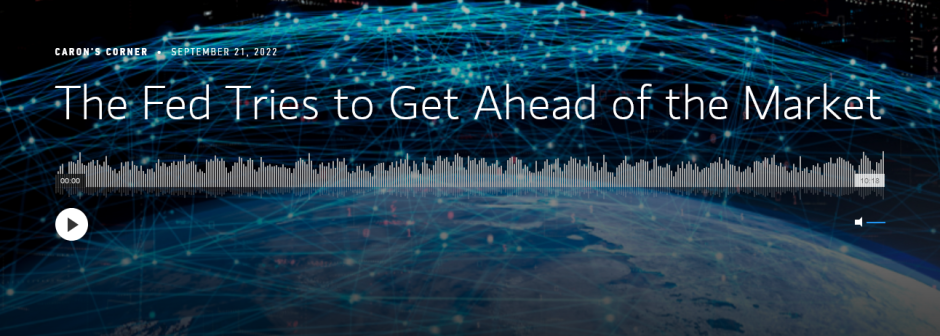
Morgan Stanley IM: The Fed Tries to Get Ahead of the Market
Jim Caron, Portfolio Manager and Chief Fixed Income Strategist, shares his macro thematic views on key market drivers.
22.09.2022 | 08:21 Uhr
- The 75 basis point (bps) rate hike came as expected, but one surprise was the 100 bps markup in end-of-year policy rates to 4.4% from 3.4%.
- The next surprise was the increase in the Fed’s forecast of their terminal policy rate to 4.5% - 4.75% from 3.8%.
- The path of rate hikes corresponds to a 75 bps hike at the November 2022 meeting, a 50 bps hike in December 2022, and a 25 bps hike in January 2023.
- Despite this aggressive pace of tightening, the Fed expects the labor market to remain strong with an unemployment rate rising only to 4.4%, while inflation simultaneously falls toward target levels of 2%-2.5%.
- While the front-loading of rate hikes may address inflation risks in the near term, it also increases the risks of recession in the longer term. This will weigh on asset valuations and tighten financial conditions.
See below for important disclosures.
Risk Considerations
Diversification does not eliminate risk of loss. There is no assurance that a portfolio will achieve its investment objective. Portfolios are subject to market risk, which is the possibility that the market values of securities owned by the portfolio will decline and that the value of portfolio shares may therefore be less than what you paid for them. Market values can change daily due to economic and other events (e.g. natural disasters, health crises, terrorism, conflicts and social unrest) that affect markets, countries, companies or governments. It is difficult to predict the timing, duration, and potential adverse effects (e.g. portfolio liquidity) of events. Accordingly, you can lose money investing in this portfolio. Please be aware that this portfolio may be subject to certain additional risks. Fixed income securities are subject to the ability of an issuer to make timely principal and interest payments (credit risk), changes in interest rates (interest-rate risk), the creditworthiness of the issuer and general market liquidity (market risk). In a rising interest-rate environment, bond prices may fall and may result in periods of volatility and increased portfolio redemptions. In a declining interest-rate environment, the portfolio may generate less income. Longer-term securities may be more sensitive to interest rate changes. Mortgage- and asset-backed securities are sensitive to early prepayment risk and a higher risk of default, and may be hard to value and difficult to sell (liquidity risk). They are also subject to credit, market and interest rate risks. Certain U.S. government securities purchased by the Strategy, such as those issued by Fannie Mae and Freddie Mac, are not backed by the full faith and credit of the U.S. It is possible that these issuers will not have the funds to meet their payment obligations in the future. High-yield securities (“junk bonds”) are lower-rated securities that may have a higher degree of credit and liquidity risk. Public bank loans are subject to liquidity risk and the credit risks of lower-rated securities. Foreign securities are subject to currency, political, economic and market risks. The risks of investing emerging market countries are greater than risks associated with investments in foreign developed countries. Sovereign debt securities are subject to default risk. Derivative instruments may disproportionately increase losses and have a significant impact on performance. They also may be subject to counterparty, liquidity, valuation, correlation and market risks. Restricted and illiquid securities may be more difficult to sell and value than publicly traded securities (liquidity risk).





Diesen Beitrag teilen: